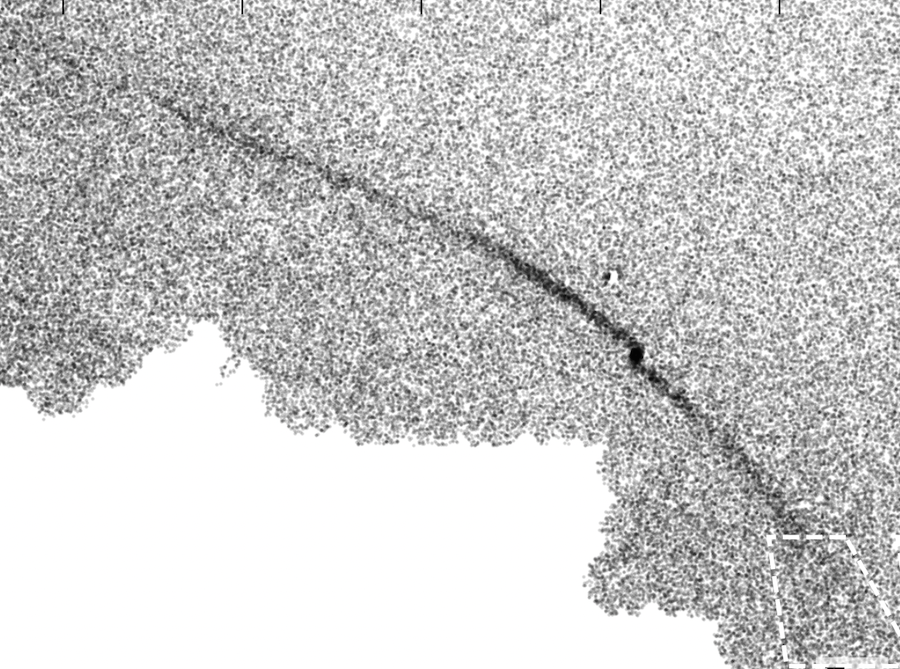STELLAR STREAMS IN THE MILKY WAY
 Stellar streams form when tidal forces from galaxies tear smaller stellar systems apart into streak-like structures that persit for billions of years in the halos of their host galaxy. Streams are sensitive to the local acceleration field of galaxies, which makes them unique probes of galactic potentials. The low velocity dispersions of thin streams emerging from globular clusters make such streams sensitive to perturbations from low-mass dark matter subhalos, which only exist if dark matter has a low free-streaming velocity. Both the halo properties and subhalo mass function depend on the mass and interactions of the dark matter particle, making streams sensitive to the nature of dark matter. In Pearson et al. (2015), they showed that the stellar stream emerging from the Milky Way globular cluster, Palomar 5, could not be reproduced in the same potential favored by models reproducing the Sagittarius stream in the Milky Way. Instead, Palomar 5 "fanned out" (did not remain thin) in the potential favored by the Sagittarius stream. Pearson has since been involved in several investigations of how the morphologies of streams are linked to properties of dark matter halos (Price-Whelan, Pearson+ 2016, Yavetz, Pearson+ 2021, Yavetz, Pearson+ 2023).
Stellar streams form when tidal forces from galaxies tear smaller stellar systems apart into streak-like structures that persit for billions of years in the halos of their host galaxy. Streams are sensitive to the local acceleration field of galaxies, which makes them unique probes of galactic potentials. The low velocity dispersions of thin streams emerging from globular clusters make such streams sensitive to perturbations from low-mass dark matter subhalos, which only exist if dark matter has a low free-streaming velocity. Both the halo properties and subhalo mass function depend on the mass and interactions of the dark matter particle, making streams sensitive to the nature of dark matter. In Pearson et al. (2015), they showed that the stellar stream emerging from the Milky Way globular cluster, Palomar 5, could not be reproduced in the same potential favored by models reproducing the Sagittarius stream in the Milky Way. Instead, Palomar 5 "fanned out" (did not remain thin) in the potential favored by the Sagittarius stream. Pearson has since been involved in several investigations of how the morphologies of streams are linked to properties of dark matter halos (Price-Whelan, Pearson+ 2016, Yavetz, Pearson+ 2021, Yavetz, Pearson+ 2023).
 Using a model of how globular clusters form and evolve, in Pearson, Bonaca et al. 2024 we predict that galaxies like the Milky Way should have formed about 10,000 massive clusters. Most have since dissolved, but around 1,000 should still survive today as thin stellar streams. Only about 80 such fully disrupted GC streams are currently known in the Milky Way, which means we have likely found less than 10 percent of them. Future deep surveys, such as the Rubin Observatory’s Legacy Survey of Space and Time, could reveal hundreds more, even far out in the halo beyond a galactocentric radius of 15 kpc (see figure). These discoveries will provide a powerful way to explore dark matter substructure in the outskirts of the Milky Way.
Using a model of how globular clusters form and evolve, in Pearson, Bonaca et al. 2024 we predict that galaxies like the Milky Way should have formed about 10,000 massive clusters. Most have since dissolved, but around 1,000 should still survive today as thin stellar streams. Only about 80 such fully disrupted GC streams are currently known in the Milky Way, which means we have likely found less than 10 percent of them. Future deep surveys, such as the Rubin Observatory’s Legacy Survey of Space and Time, could reveal hundreds more, even far out in the halo beyond a galactocentric radius of 15 kpc (see figure). These discoveries will provide a powerful way to explore dark matter substructure in the outskirts of the Milky Way.